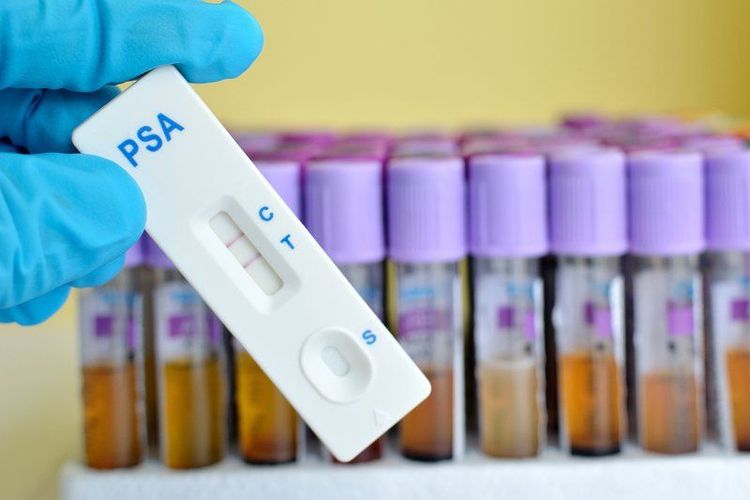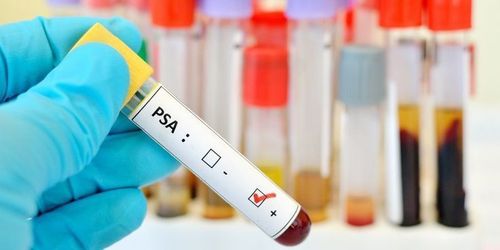This is an automatically translated article.
The article was consulted with MSc Do Thi Hoang Ha - Doctor of Biochemistry, Laboratory Department - Vinmec Hai Phong International General Hospital.Using cancer screening tests in general or using PSA to recognize early signs of prostate cancer in particular is a problem that middle-aged men should consider.
1. Prostate Cancer Overview
The prostate gland is a small gland located under the bladder in men, in front of the large intestine. It surrounds the urethra, the urinary tube inside the penis through which urine and semen are released. Prostate cancer is a fairly common disease in men worldwide and has a high potential for death (the second leading cause of death after lung cancer). Mild prostate cancer can live for many years if detected in time.Major factors that contribute to an increased risk of prostate cancer include:
Age: The older a man is, the more likely he is to develop the disease, especially after age 50. Race: People of African descent are often more susceptible to this disease than men of other races, followed by Europeans, Asians have the lowest incidence. Family history: More than 50% chance of developing prostate cancer if their father, uncle or brother was diagnosed with the disease before age 65. Inherited genetic mutations: Genetic testing is recommended if there is a family history of cancer or if a blood relative has been diagnosed with mutations in the BRCA1 and BRCA2 genes. Diet: Eating a lot of animal fat and low in vegetables may increase the risk of prostate cancer. In fact, not all cases of prostate cancer require surgical intervention. This is because the disease often progresses slowly over many years, may not cause any symptoms or have any adverse effects on the patient for the duration of the prostate cancer diagnosis – which is the most common form of prostate cancer. hidden prostate cancer. Prostate cancer is the only type of cancer that exists under two forms - latent and clinically manifest. Determinants of treatment indications include age, health status of the patient, risk of disease development (serum PSA level, clinical stage, Gleason score).
In addition, the risks and possible side effects during the healing process such as: urinary incontinence, erectile dysfunction or bowel dysfunction are also another reason that doctors and patients person must consider.
2. What is PSA?
2.1. Define

PSA is mainly found in semen, a small amount also circulates into the bloodstream. Prostate cancer cells often make more PSA than benign cells, causing PSA levels in the patient's blood to rise. Normally, PSA levels in the blood of healthy men are very low. The presence of PSA in high blood levels is often associated with abnormalities in the prostate gland, indicating the extent of the disease and the progression of the tumor. However, a small percentage of men can have elevated PSA levels even without prostate cancer (benign prostatic hypertrophy, prostatitis, prostate irritation ..) free PSA as well as determine the fPSA/TPSA ratio for differential diagnosis.
2.2. When should the PSA test be performed?
Most health organizations encourage men in their 50s to consider prostate cancer screening. May be performed earlier in men aged 40 years and older if there is a family history (father or brother with prostate cancer). However, it is necessary to discuss with your doctor to understand the necessary information before conducting the test. Many experts also recommend that men aged 70 and over do not need to be tested for this disease, especially when they are experiencing other health problems and symptoms of cancer. prostate cancer is not clear.For men who have been diagnosed with prostate cancer, continuing periodic PSA screening also helps physicians assess the mortality risk of patients with localized prostate cancer. , monitoring the effectiveness of the treatment process as well as the growth or recurrence of cancer cells depending on the risk level of the disease.
3. Method of measuring PSA
The medical staff will take a blood sample from a vein, the sample will be analyzed in a laboratory to quantify the patient's PSA level. PSA test results are measured in ng (nanograms)/mL and do not include the average value of a healthy person. To evaluate a patient's PSA, doctors will need to consider a number of other factors such as:Age Size of the prostate gland How quickly PSA changes The medications the patient is taking have an effect for PSA results Your doctor may recommend a prostate biopsy (taking a sample of cells or tissue in this area for a chemical test) based on the results of the PSA test. This test is crucial in the early diagnosis of prostate cancer. This test is sometimes combined with a digital rectal exam (DRE) to feel for abnormalities in the prostate, such as an abnormal lump or lump.
4. Meaning of Prostate Cancer Screening Tool
4.1. Advantages
Screening with PSA test helps detect prostate cancer early, thereby helping patients get appropriate, timely treatment, or even cure if diagnosed at an early stage. sick. Similar to other common blood tests, performing the PSA test is simple and does not require high technology or modern machinery. The PSA test is objective, independent of the examiner, avoiding the patient's anxiety, providing a certain peace of mind, helping men to proactively understand their own health status. The number of deaths from prostate cancer has decreased since the introduction of the PSA test, and the test was included in the US Food and Drug Administration's recommendation for cancer screening in men over the age of 50. above.4.2. Defect
Many people think that the disadvantages of prostate cancer screening outweigh the benefits. That is
At Vinmec International General Hospital, a team of experienced doctors in the field of urology - prostate will give useful advice before and after conducting the test, suitable for each patient's condition. sick. When to measure PSA, how often to do the test, and what to do next when the results are good or not are different for each man, depending on certain circumstances.
Please dial HOTLINE for more information or register for an appointment HERE. Download MyVinmec app to make appointments faster and to manage your bookings easily.
Articles refer to the source mayoclinic.org













